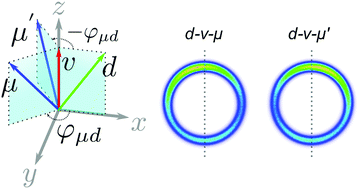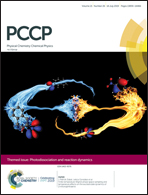Vectorial imaging of the photodissociation of 2-bromobutane oriented via hexapolar state selection
Abstract
Molecular orientation techniques are becoming available in the study of elementary chemical processes, in order to highlight those structural and dynamical properties that would be concealed by random rotational motions. Recently successful orientation was achieved for asymmetric-top and chiral molecules of much larger complexity than hitherto. In this work, we report and discuss the correlation between the vectors’ photofragment recoil velocity v, transition dipole moment μ, and permanent dipole moment d in a dissociation experiment on hexapole oriented 2-bromobutane, photoinitiated by a linearly polarized laser. The sliced ion images of the Br*(2P1/2) and Br(2P3/2) photofragments were acquired at 234.0 and 254.1 nm, respectively, by a (2 + 1) resonance-enhanced multiphoton ionization technique. A detailed analysis of the sliced ion images obtained at a tilting angle 45° of laser polarization provides information on the correlation of the three vectors, which are confined by two polar angles α and χ and one azimuthal angle φμd in the recoil frame. The sliced ion images of Br fragments eliminated individually from the enantiomers at 254.1 nm yield an asymmetric factor close to zero; for this reason the photofragment angular distributions do not show significant differences. The elimination of the Br* fragment at 234.0 nm is mainly correlated with a parallel transition, giving rise to a large anisotropy parameter of 1.85, and thus can be considered as a single state excitation. The resulting recoil frame angles are optimized to 163° ± 8° and 164° ± 1° for α and χ, respectively, whereas φμd is approaching 0° for the best fit. Since for the present molecule, the three vectors have an only slight spatial arrangement, the photofragment angular distributions of the two enantiomers do not show appreciable differences. Theoretical and computational simulations provide us the basis to state that oriented enantiomers can be discriminated on-the-fly in photodissociation processes even initiated by non-circularly polarized light, provided that the three vectors encountered above have specific three-dimensional arrangements. The fact that Br fragment elimination involves a multi-potential dissociation carries uncertainties in theoretical estimates of the vector direction. Therefore, this work represents a preliminary but significant step on the road to chiral discrimination on-the-fly, which is shown to be best propitiated in molecules where vectors are far from having degenerate mutual angular directions.

- This article is part of the themed collection: Photodissociation and reaction dynamics


 Please wait while we load your content...
Please wait while we load your content...